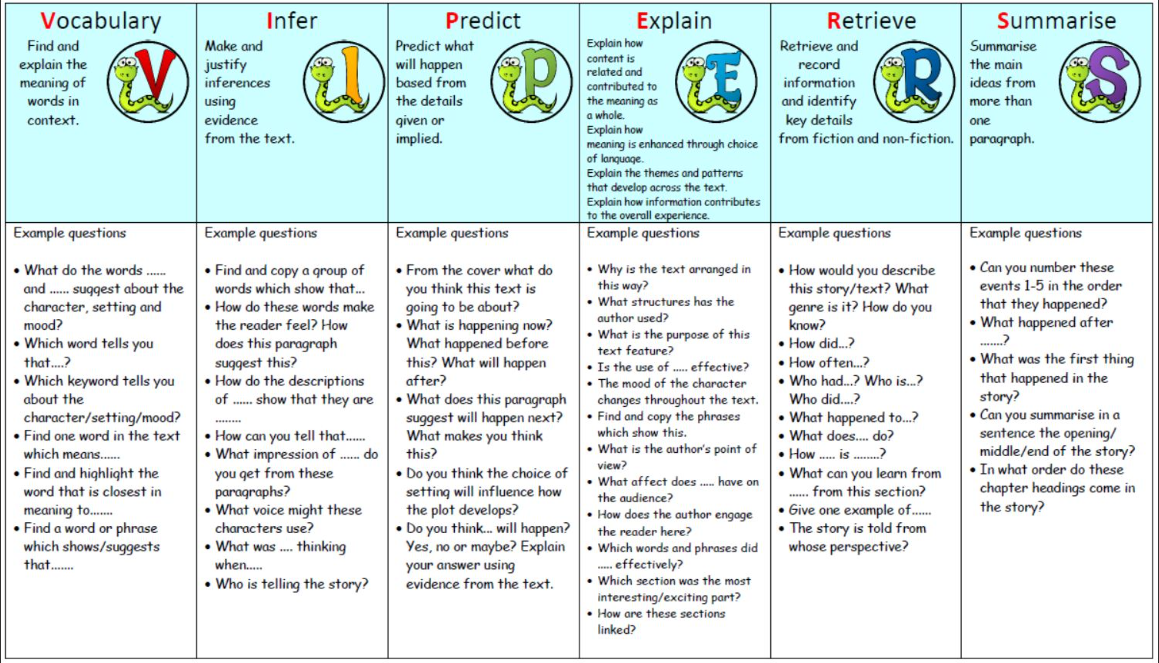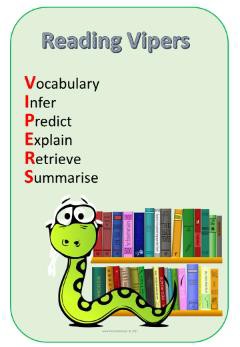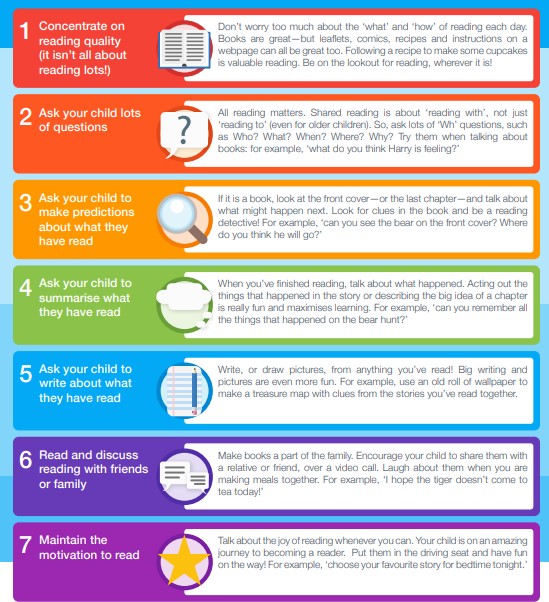Reading KS2
Reading Implementation
Whole Class Reading
Whole Class Reading provides the teacher with an opportunity for the teacher to teach reading in relation to the needs of the pupil groups and their level of achievement.
The teaching of reading at KS2 takes place within the English lessons. At the start of a new unit children are introduced to model texts and extracts. In addition, children have an additional three standalone reading lessons a week.
Whilst ensuring all elements of the National Curriculum are taught there is a focus on the reading VIPERS when teaching reading skills. This is a child-friendly way of helping children understand some of the skills they when reading. Each letter stands for a different reading skill.
V – vocabulary
I – inference (read between the lines)
P - prediction
E – explain
R - retrieve
S – summarise

The teaching of reading follows the following structure:
- Share a text with the class focusing on the Vocabulary VIPER.
- Explicitly teach one of the VIPER skills.
- Apply the specific VIPER skill to the text through a range of suitable challenges, which progress in difficultly. Children can decide on an appropriate starting point when completing challenges. It is essential that challenges are linear and that children of ALL abilities have the opportunity to access and complete ALL the challenges.
Reading as a Reader and Reading as a Writer
In addition to explicitly learning the reading VIPER skills children will learn how to use what they have read to develop their own writing. Looking at the language, features and structure of different texts and thinking about how writers carefully craft texts to suit the purpose and audience. This will be introduced in LKS2 and developed in UKS2.
Children will then begin to read as a writer, annotating the text with the features specific to its genre.
Independent Reading
Children need to be given the opportunity and encouragement to read independently in order to build confidence, stamina and fluency, as well as develop their experience of a range of books and authors.
In KS2, children will be given the opportunity to read independently first thing in the morning and from 12:50 until 13:10 every day.
Children will be expected to take their Accelerated Reading book home every evening and bring it back into school every day. When children read at home, they will be asked to get their planner signed. Planners will be checked by teachers and children will be rewarded for reading at home with house points. Teachers will monitor reading at home closely and keep their key stage English lead informed by completing a record of children who are and are not reading at home. In all year groups, where children are not reading at home, teachers should contact parents/carers, attempt to support, and resolve any issues.
At some point in the year, children will also have the opportunity to take the Reading Otter home. They can write about the reading activities that have done with the Reading Otter in the home/school Reading Otter book.
Accelerated Reader
Accelerated Reader is used. This is an electronic programme, which assesses children’s reading ability and matches it to reading books ensuring children make maximum progress. Children will take part in an electronic test termly, which will give them a score (known as a z-score). This will inform them of the reading books they may choose within the library. As soon as they have finished a book, children will complete a quiz and then they can choose another book, which matches their z-score. Teacher’s will monitor children’s progress and ensure that the difficulty of the child’s reading book is adjusted as their reading ability develops.
Reading Environment
All classrooms provide a rich reading environment. Each class is named after an author and has a reading area, which reflects this. Reading areas are filled with displays that promote a love of reading; support children to develop their reading skills and have book reviews and recommendations written by the children.
Reading at Home
The teachers
We will provide an appropriate Accelerated Reading book to read at home.
- We will teach decoding, fluency and comprehension skills.
- We will ensure children read from a range of genres: narrative, non-fiction and poetry.
- We will develop children’s comprehension about a text using the VIPERS reading skills.
- We will listen to children read aloud regularly and promote a love of reading.
- We will provide opportunities for children apply their reading skills across the Curriculum.
- Read a daily class text.
- We will award children house points for reading at home and badges for completing quizzes.
The parents:
- I will listen to my child read daily and ask questions using the VIPERS question stems (see below).
- I will sign and comment in my child’s reading diary at least three times per week.
- I will ensure my child’s reading diary and book is in school daily.
- I will read regularly to my child.
The children:
- I will bring my diary and home reading book to school every day.
- I will read my home reading book at least three times per week at home.
- I will look after my home reading book.
- I will take a quiz at school when I have finished reading my book.
- I will change my book when I have completed my quiz and check my new book is the correct level with my teacher.
 |
Why is reading so important?
Nothing is more important in education than ensuring that every child can read well. Pupils who can read are overwhelmingly more likely to succeed at school, achieve good qualifications, and subsequently enjoy a fulfilling and rewarding career. Those who cannot will find themselves at constant disadvantage. (Nick Gibb MP)
What happens if I do not read and sign my diary at least three times per week?
|
Parent to read, comment and sign their child’s reading diary. (At least three times per week) |
|
Step 1: Teacher reminder. Step 2: Text message sent home. Step 3: Phone call home. |
7 Top Tips to Support Reading at Home:
 |
Celebrating Reading
Rewards for Reading
Reading should not be seen as just a ‘school activity’. Wider family involvement supports reading and ensures children have access to reading materials at home. The school target for home reading is five times a week. This should be evidenced in the reading planner by a signature from a parent/carer. Reading stickers will be provided to those children who meet this weekly target and this sticker in the back of the reading planner. Those children who read at home five times a week will receive an additional five house points.
In addition, those children who are working on the Accelerated Reader system will work towards certificates that will be handed out in Assembly. Children in KS2 will receive a house point for every time they read at home.
Accelerated Reader certificates
These are printed off weekly and celebrated in assembly. The best way to do this is for the year group lead to read the names of anyone receiving a certificate. Children can then stand up where they are sitting and all get applauded at the same time rather than come to the front. The class teachers can give them their certificates when they get back to class.
Medals
Each term those children who read the most per cohort will receive a certificate and medal. The children who improve the most in each cohort will receive a medal and certificate.
Reading OTTER
The Reading OTTER goes home with a different child each week and time is given to share this.
The Golden Book
Two golden books will be given to classes each month. One for the class who have read the most words and one for the class who have passed the most quizzes (looking at the data LKS2 get through far more books than UKS2, as the books are shorter; Upper Key Stage 2 appear to read more words, so hopefully this should work out fair).
